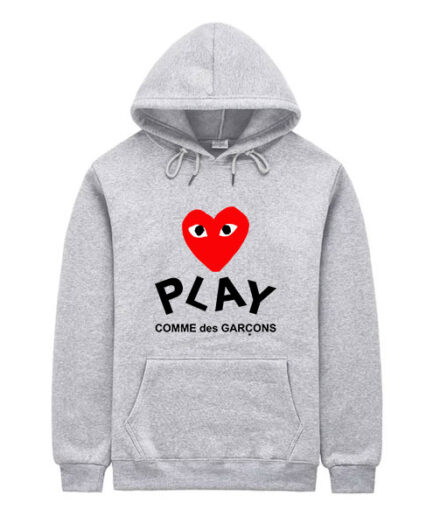Comme Des Garcons (CDG), founded by designer Rei Kawakubo in 1969, has established itself as a pioneering force in the fashion industry. Known for its avant-garde aesthetic and innovative designs, the brand has successfully merged high fashion with streetwear, particularly through its iconic hoodies. This article explores the sustainability of cdg hoodie examining their materials, production processes, and overall environmental impact.
The Rise of Hoodies in Fashion:
Hoodies have transcended their origins as utilitarian garments to become staples in contemporary fashion. Initially popularized in the 1970s and 1980s by athletes and hip-hop culture, hoodies are now embraced by luxury brands, including Comme Des Garcons. The hoodie’s versatility allows it to be styled in various ways, making it suitable for both casual and formal occasions. This shift reflects broader trends in fashion where comfort and style converge, leading to increased demand for high-quality hoodies.
Materials Used in Comme Des Garcons Hoodies:
The sustainability of a garment heavily relies on the materials used in its production. Comme Des Garcons hoodies are often crafted from a blend of cotton and polyester, which offers durability and comfort. Cotton, a natural fiber, is biodegradable and breathable, while polyester, a synthetic fiber, enhances the hoodie’s longevity. However, the environmental impact of polyester, derived from petroleum, raises concerns regarding its sustainability. To address these issues, Comme Des Garcons has begun exploring more sustainable materials. The brand is increasingly incorporating organic cotton, which is grown without harmful pesticides and fertilizers, thus reducing its ecological footprint. Additionally, the use of recycled polyester is gaining traction, allowing for the reduction of waste and the conservation of resources.
Production Processes and Ethical Considerations:
The production processes of Comme Des Garcons hoodies play a crucial role in their sustainability. The brand is committed to ethical manufacturing practices, ensuring fair labor conditions and environmentally responsible methods. Many of their garments are produced in Japan, where stringent labor laws and quality control measures are in place. However, the global nature of fashion manufacturing often leads to challenges in maintaining transparency throughout the supply chain. Comme Des Garcons has made strides in this area by emphasizing local production and working with trusted suppliers. This commitment not only supports local economies but also minimizes the carbon footprint associated with transportation.
The Role of Consumer Behavior in Sustainability:
Consumer behavior significantly impacts the sustainability of fashion brands. The growing awareness of environmental issues has led consumers to seek out brands that prioritize sustainability. Comme Des Garcons has responded to this demand by promoting the quality and longevity of their hoodies. By emphasizing that their products are designed to last, the brand encourages consumers to invest in fewer, higher-quality items rather than fast fashion alternatives. Moreover, the minimalist design of Comme Des Garcons hoodies aligns with the sustainable fashion movement, which advocates for timeless pieces that can be worn across seasons and trends. This approach not only reduces waste but also fosters a more conscious consumer mindset.
The Impact of Fashion Trends on Sustainability
Fashion trends often dictate consumer purchasing habits, which can either positively or negatively affect sustainability efforts. The rise of streetwear and athleisure has bolstered the popularity of hoodies, leading to increased production. While this trend benefits brands like Comme Des Garcons, it also raises concerns about overproduction and waste. To mitigate these issues, Comme Des Garcons is exploring limited-edition releases and collaborations, which create a sense of exclusivity and reduce the likelihood of excess inventory. By adopting a more measured approach to production, the brand can better align with sustainable practices while still appealing to fashion-forward consumers.
The Future of Sustainability in Comme Des Garcons Hoodies:
As the fashion industry grapples with the pressing need for sustainability, Comme Des Garcons is well-positioned to lead the charge. The brand’s commitment to high-quality materials, ethical production practices, and consumer education lays a solid foundation for future sustainability efforts. Looking ahead, the integration of innovative technologies, such as sustainable dyeing processes and biodegradable materials, will further enhance the sustainability of Comme Des Garcons hoodies. By staying at the forefront of these advancements, the brand can continue to set trends while minimizing its environmental impact.
Consumer Education and Awareness:
Educating consumers about the sustainability of their clothing choices is paramount. Comme Des Garcons has the opportunity to leverage its influential status in the fashion industry to promote awareness around sustainable practices. By providing information about the materials used in their hoodies and the importance of ethical manufacturing, the brand can empower consumers to make informed decisions. Additionally, engaging in initiatives such as clothing recycling programs or collaborations with sustainability-focused organizations can further enhance consumer awareness and participation in sustainable practices. These efforts not only benefit the environment but also strengthen the brand’s reputation as a leader in sustainable fashion.
Conclusion:
In conclusion, the sustainability of Comme Des Garcons hoodies is a multifaceted issue that encompasses materials, production processes, consumer behavior, and the broader fashion landscape. As the brand continues to innovate and adapt to the changing demands of consumers, its commitment to sustainability will play a crucial role in shaping its future. By prioritizing high-quality materials, ethical production, and consumer education, Comme Des Garcons can lead by example in the fashion industry. The journey towards sustainability is ongoing, but with each step, the brand moves closer to a more responsible and environmentally conscious future.
